Communication Skills for Business: Comprehensive Report
VerifiedAdded on 2020/10/05
|10
|2645
|332
Report
AI Summary
This report delves into the critical role of effective communication within a business context, examining various communication models and systems employed to facilitate efficient operations and foster growth. It explores the benefits of both formal and informal communication channels, highlighting their contributions to organizational success. The report further investigates the application of technology in diverse communication scenarios, emphasizing principles of effective communication. It then identifies and analyzes common barriers to effective communication, offering practical solutions to mitigate these challenges. The report also covers oral and written communication techniques, providing insights into their effective implementation. The report concludes by summarizing key findings and emphasizing the importance of continuous improvement in communication practices to achieve optimal business outcomes.
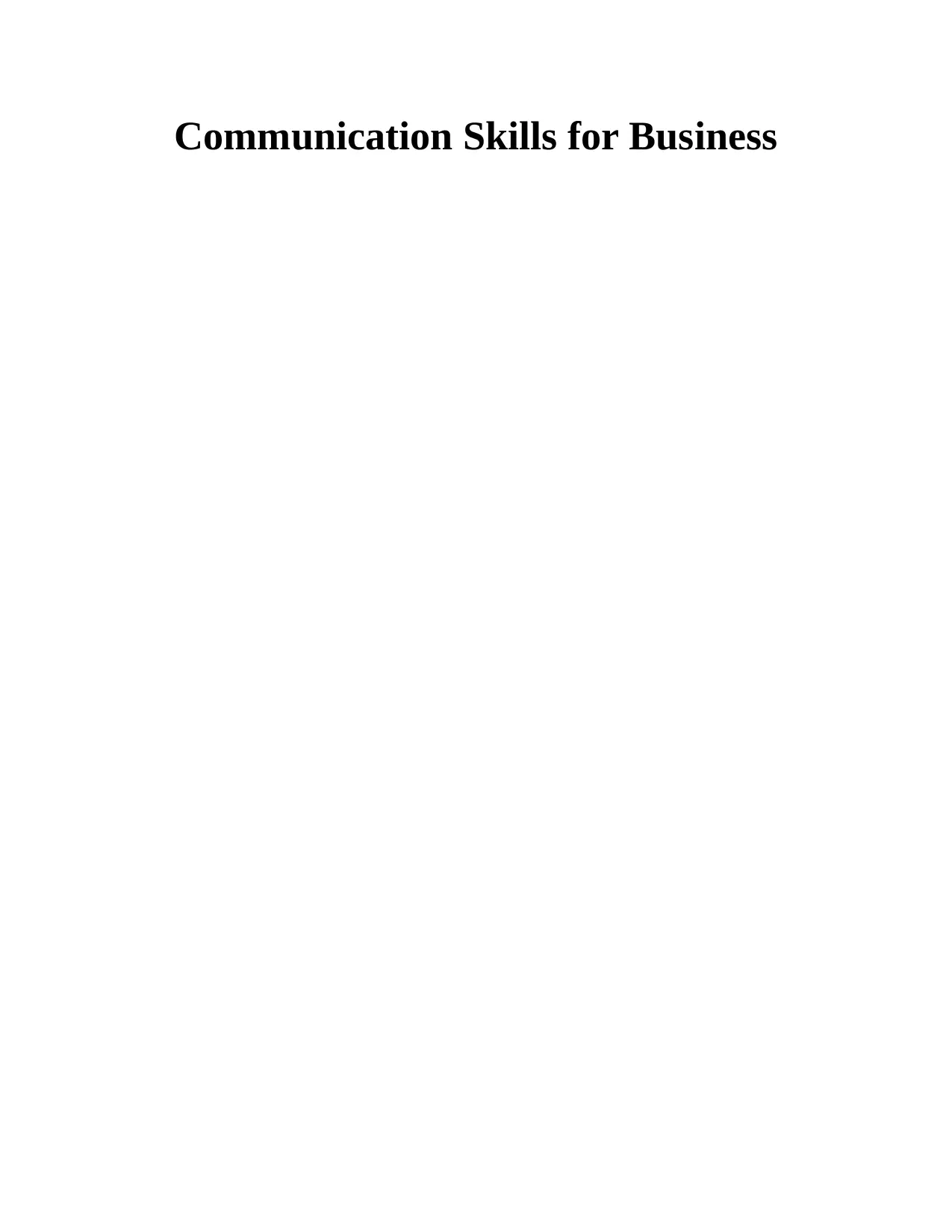
Communication Skills for Business
Paraphrase This Document
Need a fresh take? Get an instant paraphrase of this document with our AI Paraphraser
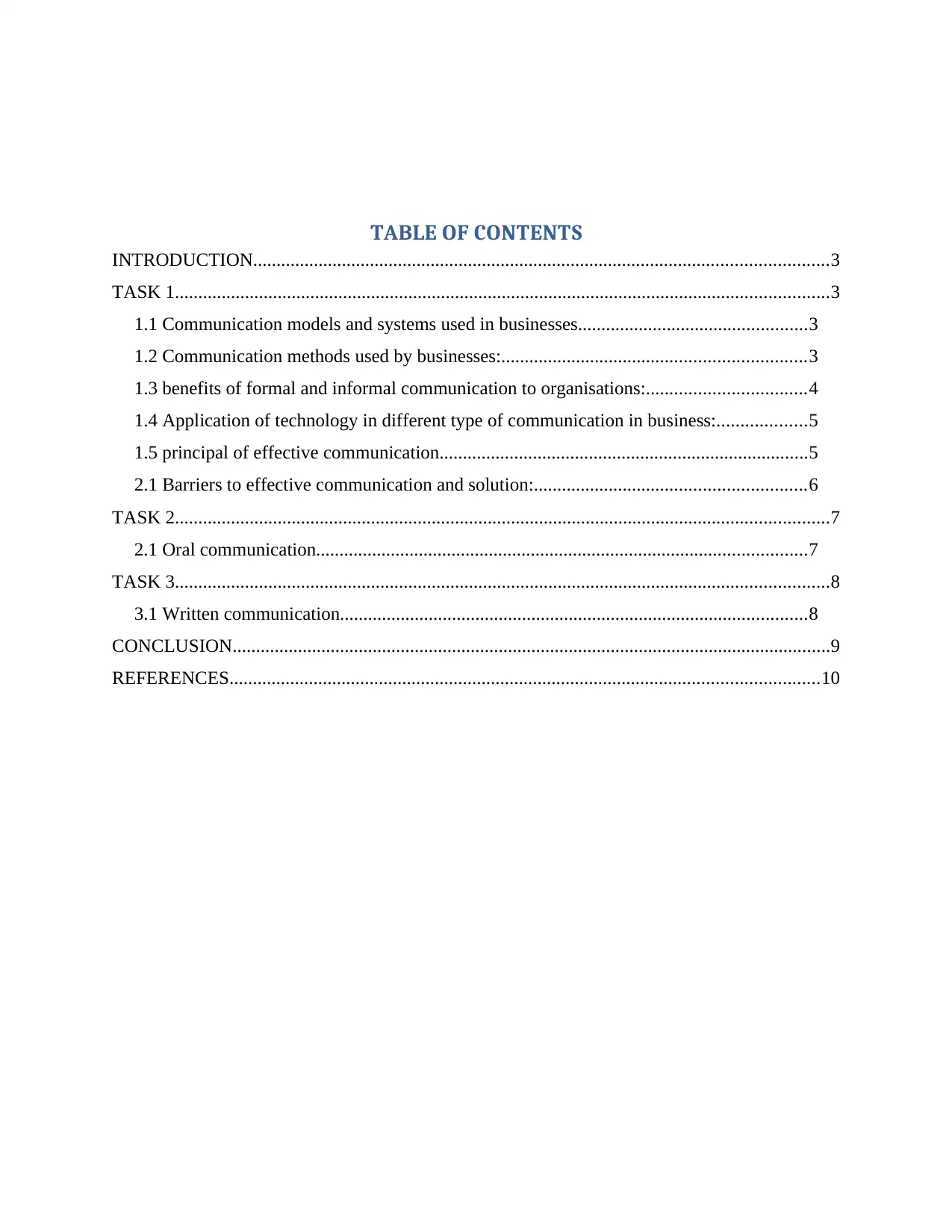
TABLE OF CONTENTS
INTRODUCTION...........................................................................................................................3
TASK 1............................................................................................................................................3
1.1 Communication models and systems used in businesses.................................................3
1.2 Communication methods used by businesses:.................................................................3
1.3 benefits of formal and informal communication to organisations:..................................4
1.4 Application of technology in different type of communication in business:...................5
1.5 principal of effective communication...............................................................................5
2.1 Barriers to effective communication and solution:..........................................................6
TASK 2............................................................................................................................................7
2.1 Oral communication.........................................................................................................7
TASK 3............................................................................................................................................8
3.1 Written communication....................................................................................................8
CONCLUSION................................................................................................................................9
REFERENCES..............................................................................................................................10
INTRODUCTION...........................................................................................................................3
TASK 1............................................................................................................................................3
1.1 Communication models and systems used in businesses.................................................3
1.2 Communication methods used by businesses:.................................................................3
1.3 benefits of formal and informal communication to organisations:..................................4
1.4 Application of technology in different type of communication in business:...................5
1.5 principal of effective communication...............................................................................5
2.1 Barriers to effective communication and solution:..........................................................6
TASK 2............................................................................................................................................7
2.1 Oral communication.........................................................................................................7
TASK 3............................................................................................................................................8
3.1 Written communication....................................................................................................8
CONCLUSION................................................................................................................................9
REFERENCES..............................................................................................................................10
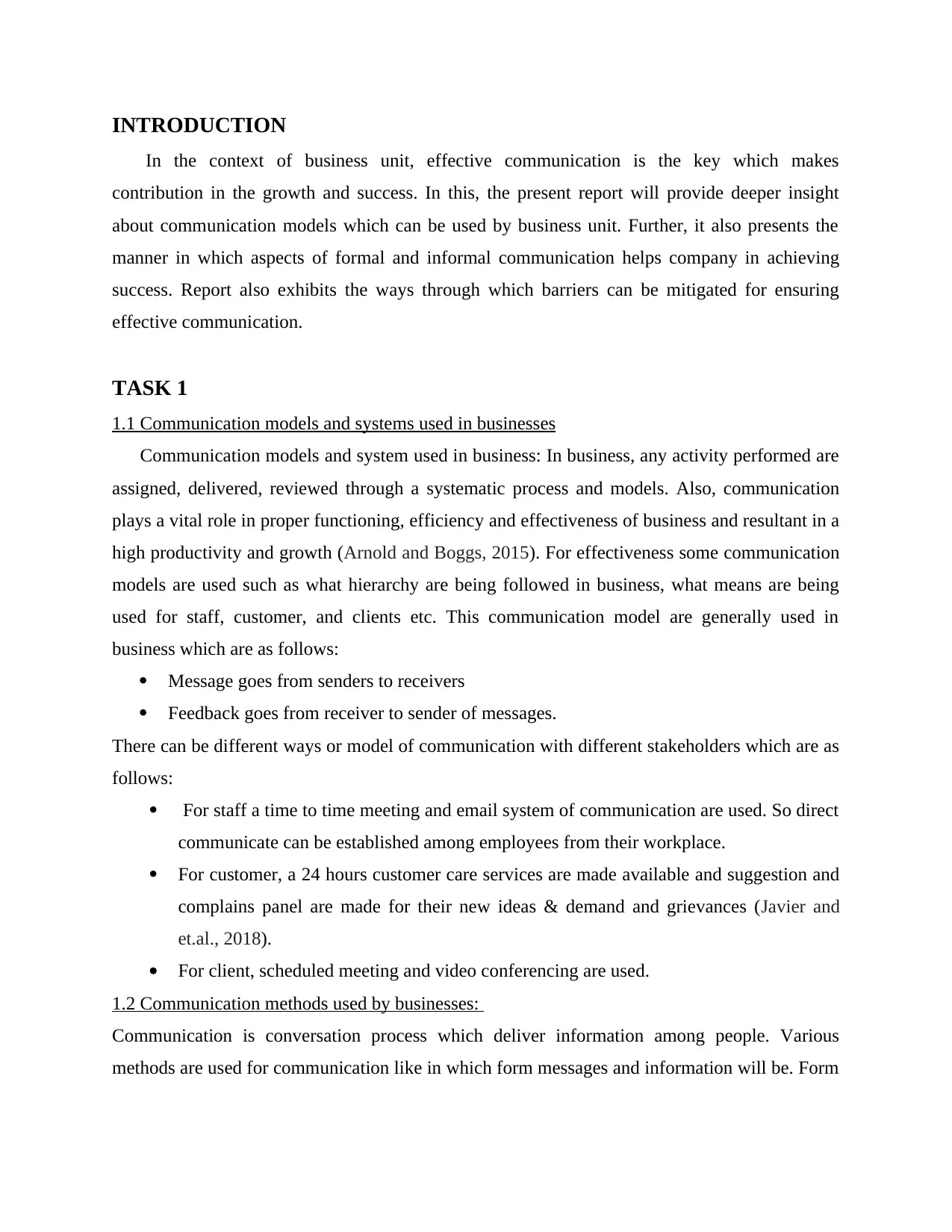
INTRODUCTION
In the context of business unit, effective communication is the key which makes
contribution in the growth and success. In this, the present report will provide deeper insight
about communication models which can be used by business unit. Further, it also presents the
manner in which aspects of formal and informal communication helps company in achieving
success. Report also exhibits the ways through which barriers can be mitigated for ensuring
effective communication.
TASK 1
1.1 Communication models and systems used in businesses
Communication models and system used in business: In business, any activity performed are
assigned, delivered, reviewed through a systematic process and models. Also, communication
plays a vital role in proper functioning, efficiency and effectiveness of business and resultant in a
high productivity and growth (Arnold and Boggs, 2015). For effectiveness some communication
models are used such as what hierarchy are being followed in business, what means are being
used for staff, customer, and clients etc. This communication model are generally used in
business which are as follows:
Message goes from senders to receivers
Feedback goes from receiver to sender of messages.
There can be different ways or model of communication with different stakeholders which are as
follows:
For staff a time to time meeting and email system of communication are used. So direct
communicate can be established among employees from their workplace.
For customer, a 24 hours customer care services are made available and suggestion and
complains panel are made for their new ideas & demand and grievances (Javier and
et.al., 2018).
For client, scheduled meeting and video conferencing are used.
1.2 Communication methods used by businesses:
Communication is conversation process which deliver information among people. Various
methods are used for communication like in which form messages and information will be. Form
In the context of business unit, effective communication is the key which makes
contribution in the growth and success. In this, the present report will provide deeper insight
about communication models which can be used by business unit. Further, it also presents the
manner in which aspects of formal and informal communication helps company in achieving
success. Report also exhibits the ways through which barriers can be mitigated for ensuring
effective communication.
TASK 1
1.1 Communication models and systems used in businesses
Communication models and system used in business: In business, any activity performed are
assigned, delivered, reviewed through a systematic process and models. Also, communication
plays a vital role in proper functioning, efficiency and effectiveness of business and resultant in a
high productivity and growth (Arnold and Boggs, 2015). For effectiveness some communication
models are used such as what hierarchy are being followed in business, what means are being
used for staff, customer, and clients etc. This communication model are generally used in
business which are as follows:
Message goes from senders to receivers
Feedback goes from receiver to sender of messages.
There can be different ways or model of communication with different stakeholders which are as
follows:
For staff a time to time meeting and email system of communication are used. So direct
communicate can be established among employees from their workplace.
For customer, a 24 hours customer care services are made available and suggestion and
complains panel are made for their new ideas & demand and grievances (Javier and
et.al., 2018).
For client, scheduled meeting and video conferencing are used.
1.2 Communication methods used by businesses:
Communication is conversation process which deliver information among people. Various
methods are used for communication like in which form messages and information will be. Form
⊘ This is a preview!⊘
Do you want full access?
Subscribe today to unlock all pages.

Trusted by 1+ million students worldwide
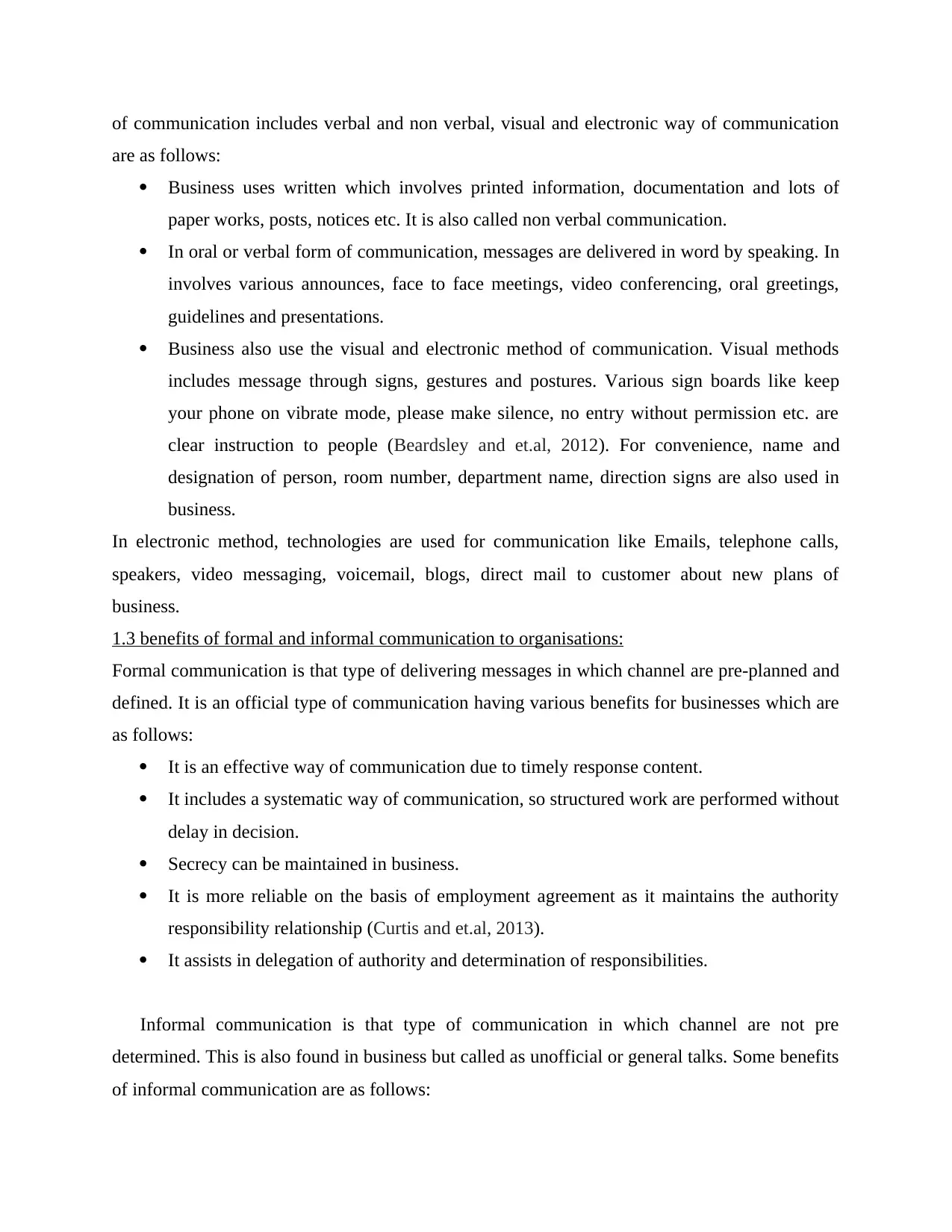
of communication includes verbal and non verbal, visual and electronic way of communication
are as follows:
Business uses written which involves printed information, documentation and lots of
paper works, posts, notices etc. It is also called non verbal communication.
In oral or verbal form of communication, messages are delivered in word by speaking. In
involves various announces, face to face meetings, video conferencing, oral greetings,
guidelines and presentations.
Business also use the visual and electronic method of communication. Visual methods
includes message through signs, gestures and postures. Various sign boards like keep
your phone on vibrate mode, please make silence, no entry without permission etc. are
clear instruction to people (Beardsley and et.al, 2012). For convenience, name and
designation of person, room number, department name, direction signs are also used in
business.
In electronic method, technologies are used for communication like Emails, telephone calls,
speakers, video messaging, voicemail, blogs, direct mail to customer about new plans of
business.
1.3 benefits of formal and informal communication to organisations:
Formal communication is that type of delivering messages in which channel are pre-planned and
defined. It is an official type of communication having various benefits for businesses which are
as follows:
It is an effective way of communication due to timely response content.
It includes a systematic way of communication, so structured work are performed without
delay in decision.
Secrecy can be maintained in business.
It is more reliable on the basis of employment agreement as it maintains the authority
responsibility relationship (Curtis and et.al, 2013).
It assists in delegation of authority and determination of responsibilities.
Informal communication is that type of communication in which channel are not pre
determined. This is also found in business but called as unofficial or general talks. Some benefits
of informal communication are as follows:
are as follows:
Business uses written which involves printed information, documentation and lots of
paper works, posts, notices etc. It is also called non verbal communication.
In oral or verbal form of communication, messages are delivered in word by speaking. In
involves various announces, face to face meetings, video conferencing, oral greetings,
guidelines and presentations.
Business also use the visual and electronic method of communication. Visual methods
includes message through signs, gestures and postures. Various sign boards like keep
your phone on vibrate mode, please make silence, no entry without permission etc. are
clear instruction to people (Beardsley and et.al, 2012). For convenience, name and
designation of person, room number, department name, direction signs are also used in
business.
In electronic method, technologies are used for communication like Emails, telephone calls,
speakers, video messaging, voicemail, blogs, direct mail to customer about new plans of
business.
1.3 benefits of formal and informal communication to organisations:
Formal communication is that type of delivering messages in which channel are pre-planned and
defined. It is an official type of communication having various benefits for businesses which are
as follows:
It is an effective way of communication due to timely response content.
It includes a systematic way of communication, so structured work are performed without
delay in decision.
Secrecy can be maintained in business.
It is more reliable on the basis of employment agreement as it maintains the authority
responsibility relationship (Curtis and et.al, 2013).
It assists in delegation of authority and determination of responsibilities.
Informal communication is that type of communication in which channel are not pre
determined. This is also found in business but called as unofficial or general talks. Some benefits
of informal communication are as follows:
Paraphrase This Document
Need a fresh take? Get an instant paraphrase of this document with our AI Paraphraser
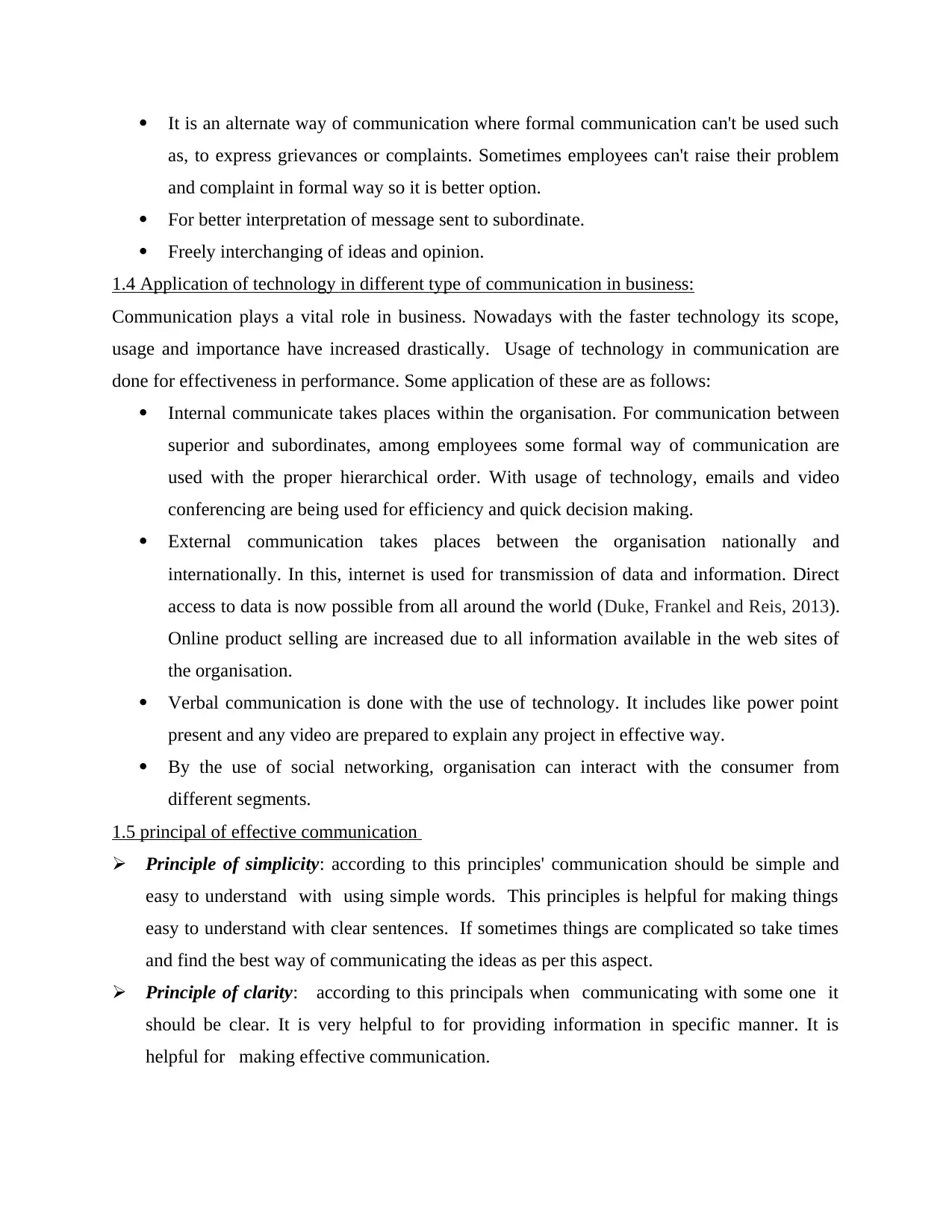
It is an alternate way of communication where formal communication can't be used such
as, to express grievances or complaints. Sometimes employees can't raise their problem
and complaint in formal way so it is better option.
For better interpretation of message sent to subordinate.
Freely interchanging of ideas and opinion.
1.4 Application of technology in different type of communication in business:
Communication plays a vital role in business. Nowadays with the faster technology its scope,
usage and importance have increased drastically. Usage of technology in communication are
done for effectiveness in performance. Some application of these are as follows:
Internal communicate takes places within the organisation. For communication between
superior and subordinates, among employees some formal way of communication are
used with the proper hierarchical order. With usage of technology, emails and video
conferencing are being used for efficiency and quick decision making.
External communication takes places between the organisation nationally and
internationally. In this, internet is used for transmission of data and information. Direct
access to data is now possible from all around the world (Duke, Frankel and Reis, 2013).
Online product selling are increased due to all information available in the web sites of
the organisation.
Verbal communication is done with the use of technology. It includes like power point
present and any video are prepared to explain any project in effective way.
By the use of social networking, organisation can interact with the consumer from
different segments.
1.5 principal of effective communication
Principle of simplicity: according to this principles' communication should be simple and
easy to understand with using simple words. This principles is helpful for making things
easy to understand with clear sentences. If sometimes things are complicated so take times
and find the best way of communicating the ideas as per this aspect.
Principle of clarity: according to this principals when communicating with some one it
should be clear. It is very helpful to for providing information in specific manner. It is
helpful for making effective communication.
as, to express grievances or complaints. Sometimes employees can't raise their problem
and complaint in formal way so it is better option.
For better interpretation of message sent to subordinate.
Freely interchanging of ideas and opinion.
1.4 Application of technology in different type of communication in business:
Communication plays a vital role in business. Nowadays with the faster technology its scope,
usage and importance have increased drastically. Usage of technology in communication are
done for effectiveness in performance. Some application of these are as follows:
Internal communicate takes places within the organisation. For communication between
superior and subordinates, among employees some formal way of communication are
used with the proper hierarchical order. With usage of technology, emails and video
conferencing are being used for efficiency and quick decision making.
External communication takes places between the organisation nationally and
internationally. In this, internet is used for transmission of data and information. Direct
access to data is now possible from all around the world (Duke, Frankel and Reis, 2013).
Online product selling are increased due to all information available in the web sites of
the organisation.
Verbal communication is done with the use of technology. It includes like power point
present and any video are prepared to explain any project in effective way.
By the use of social networking, organisation can interact with the consumer from
different segments.
1.5 principal of effective communication
Principle of simplicity: according to this principles' communication should be simple and
easy to understand with using simple words. This principles is helpful for making things
easy to understand with clear sentences. If sometimes things are complicated so take times
and find the best way of communicating the ideas as per this aspect.
Principle of clarity: according to this principals when communicating with some one it
should be clear. It is very helpful to for providing information in specific manner. It is
helpful for making effective communication.
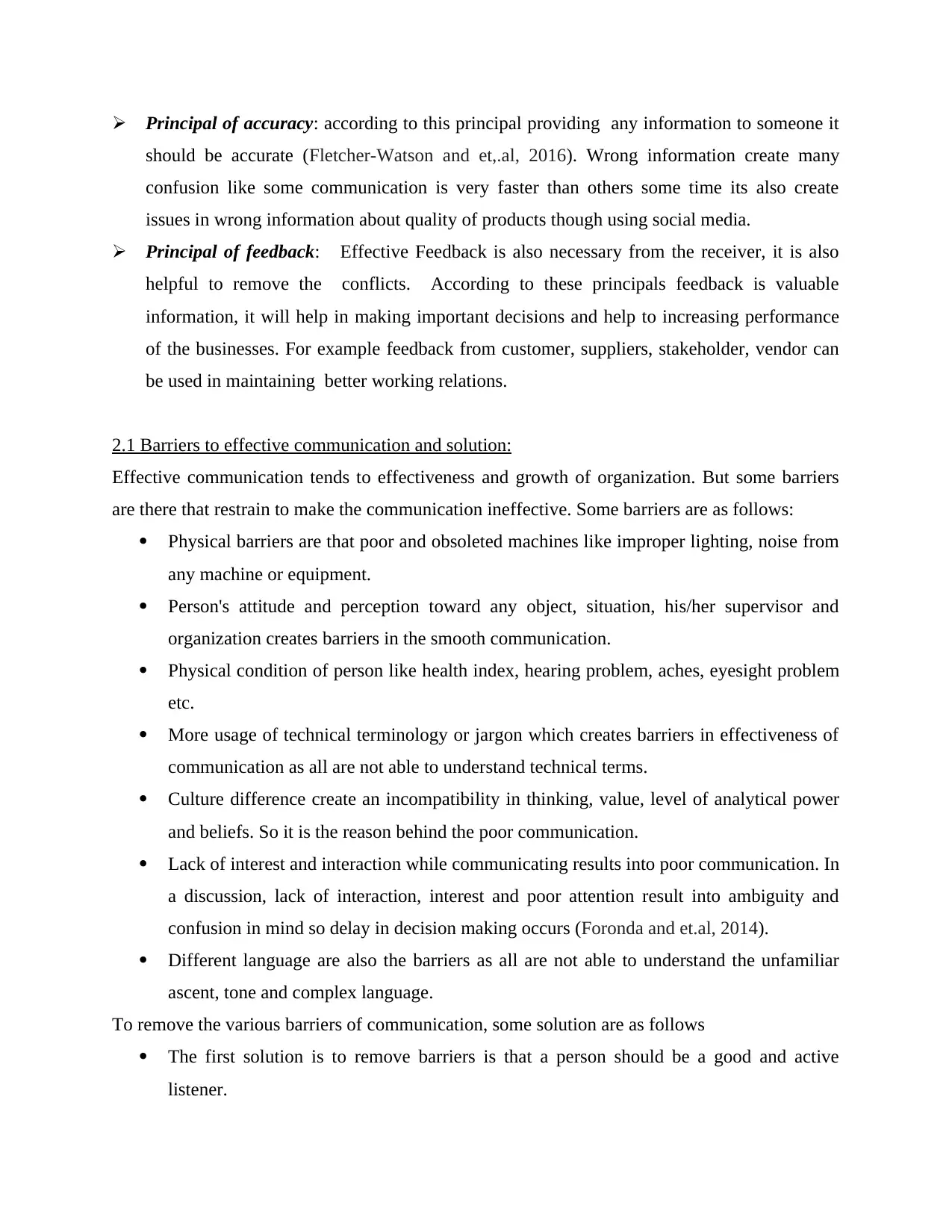
Principal of accuracy: according to this principal providing any information to someone it
should be accurate (Fletcher-Watson and et,.al, 2016). Wrong information create many
confusion like some communication is very faster than others some time its also create
issues in wrong information about quality of products though using social media.
Principal of feedback: Effective Feedback is also necessary from the receiver, it is also
helpful to remove the conflicts. According to these principals feedback is valuable
information, it will help in making important decisions and help to increasing performance
of the businesses. For example feedback from customer, suppliers, stakeholder, vendor can
be used in maintaining better working relations.
2.1 Barriers to effective communication and solution:
Effective communication tends to effectiveness and growth of organization. But some barriers
are there that restrain to make the communication ineffective. Some barriers are as follows:
Physical barriers are that poor and obsoleted machines like improper lighting, noise from
any machine or equipment.
Person's attitude and perception toward any object, situation, his/her supervisor and
organization creates barriers in the smooth communication.
Physical condition of person like health index, hearing problem, aches, eyesight problem
etc.
More usage of technical terminology or jargon which creates barriers in effectiveness of
communication as all are not able to understand technical terms.
Culture difference create an incompatibility in thinking, value, level of analytical power
and beliefs. So it is the reason behind the poor communication.
Lack of interest and interaction while communicating results into poor communication. In
a discussion, lack of interaction, interest and poor attention result into ambiguity and
confusion in mind so delay in decision making occurs (Foronda and et.al, 2014).
Different language are also the barriers as all are not able to understand the unfamiliar
ascent, tone and complex language.
To remove the various barriers of communication, some solution are as follows
The first solution is to remove barriers is that a person should be a good and active
listener.
should be accurate (Fletcher-Watson and et,.al, 2016). Wrong information create many
confusion like some communication is very faster than others some time its also create
issues in wrong information about quality of products though using social media.
Principal of feedback: Effective Feedback is also necessary from the receiver, it is also
helpful to remove the conflicts. According to these principals feedback is valuable
information, it will help in making important decisions and help to increasing performance
of the businesses. For example feedback from customer, suppliers, stakeholder, vendor can
be used in maintaining better working relations.
2.1 Barriers to effective communication and solution:
Effective communication tends to effectiveness and growth of organization. But some barriers
are there that restrain to make the communication ineffective. Some barriers are as follows:
Physical barriers are that poor and obsoleted machines like improper lighting, noise from
any machine or equipment.
Person's attitude and perception toward any object, situation, his/her supervisor and
organization creates barriers in the smooth communication.
Physical condition of person like health index, hearing problem, aches, eyesight problem
etc.
More usage of technical terminology or jargon which creates barriers in effectiveness of
communication as all are not able to understand technical terms.
Culture difference create an incompatibility in thinking, value, level of analytical power
and beliefs. So it is the reason behind the poor communication.
Lack of interest and interaction while communicating results into poor communication. In
a discussion, lack of interaction, interest and poor attention result into ambiguity and
confusion in mind so delay in decision making occurs (Foronda and et.al, 2014).
Different language are also the barriers as all are not able to understand the unfamiliar
ascent, tone and complex language.
To remove the various barriers of communication, some solution are as follows
The first solution is to remove barriers is that a person should be a good and active
listener.
⊘ This is a preview!⊘
Do you want full access?
Subscribe today to unlock all pages.

Trusted by 1+ million students worldwide
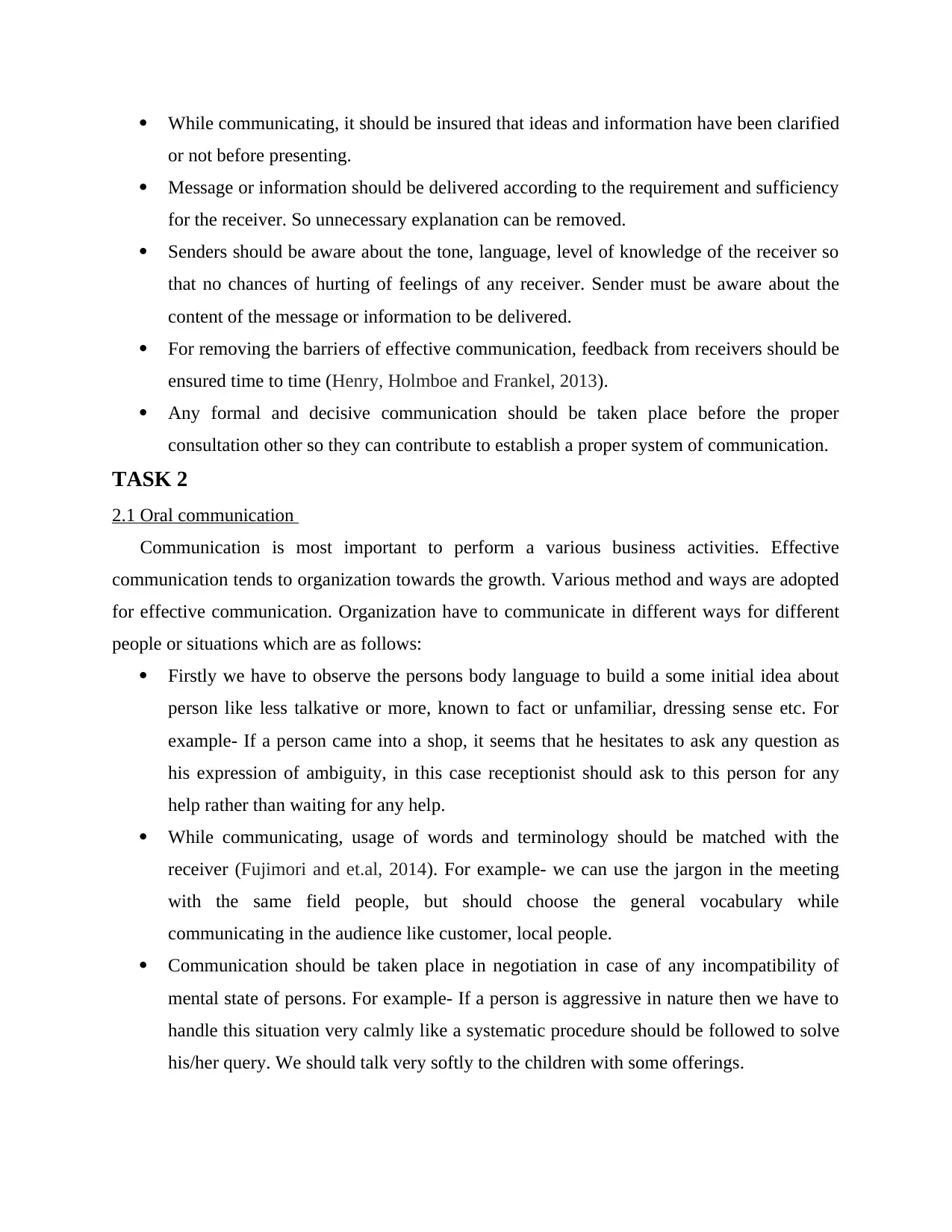
While communicating, it should be insured that ideas and information have been clarified
or not before presenting.
Message or information should be delivered according to the requirement and sufficiency
for the receiver. So unnecessary explanation can be removed.
Senders should be aware about the tone, language, level of knowledge of the receiver so
that no chances of hurting of feelings of any receiver. Sender must be aware about the
content of the message or information to be delivered.
For removing the barriers of effective communication, feedback from receivers should be
ensured time to time (Henry, Holmboe and Frankel, 2013).
Any formal and decisive communication should be taken place before the proper
consultation other so they can contribute to establish a proper system of communication.
TASK 2
2.1 Oral communication
Communication is most important to perform a various business activities. Effective
communication tends to organization towards the growth. Various method and ways are adopted
for effective communication. Organization have to communicate in different ways for different
people or situations which are as follows:
Firstly we have to observe the persons body language to build a some initial idea about
person like less talkative or more, known to fact or unfamiliar, dressing sense etc. For
example- If a person came into a shop, it seems that he hesitates to ask any question as
his expression of ambiguity, in this case receptionist should ask to this person for any
help rather than waiting for any help.
While communicating, usage of words and terminology should be matched with the
receiver (Fujimori and et.al, 2014). For example- we can use the jargon in the meeting
with the same field people, but should choose the general vocabulary while
communicating in the audience like customer, local people.
Communication should be taken place in negotiation in case of any incompatibility of
mental state of persons. For example- If a person is aggressive in nature then we have to
handle this situation very calmly like a systematic procedure should be followed to solve
his/her query. We should talk very softly to the children with some offerings.
or not before presenting.
Message or information should be delivered according to the requirement and sufficiency
for the receiver. So unnecessary explanation can be removed.
Senders should be aware about the tone, language, level of knowledge of the receiver so
that no chances of hurting of feelings of any receiver. Sender must be aware about the
content of the message or information to be delivered.
For removing the barriers of effective communication, feedback from receivers should be
ensured time to time (Henry, Holmboe and Frankel, 2013).
Any formal and decisive communication should be taken place before the proper
consultation other so they can contribute to establish a proper system of communication.
TASK 2
2.1 Oral communication
Communication is most important to perform a various business activities. Effective
communication tends to organization towards the growth. Various method and ways are adopted
for effective communication. Organization have to communicate in different ways for different
people or situations which are as follows:
Firstly we have to observe the persons body language to build a some initial idea about
person like less talkative or more, known to fact or unfamiliar, dressing sense etc. For
example- If a person came into a shop, it seems that he hesitates to ask any question as
his expression of ambiguity, in this case receptionist should ask to this person for any
help rather than waiting for any help.
While communicating, usage of words and terminology should be matched with the
receiver (Fujimori and et.al, 2014). For example- we can use the jargon in the meeting
with the same field people, but should choose the general vocabulary while
communicating in the audience like customer, local people.
Communication should be taken place in negotiation in case of any incompatibility of
mental state of persons. For example- If a person is aggressive in nature then we have to
handle this situation very calmly like a systematic procedure should be followed to solve
his/her query. We should talk very softly to the children with some offerings.
Paraphrase This Document
Need a fresh take? Get an instant paraphrase of this document with our AI Paraphraser
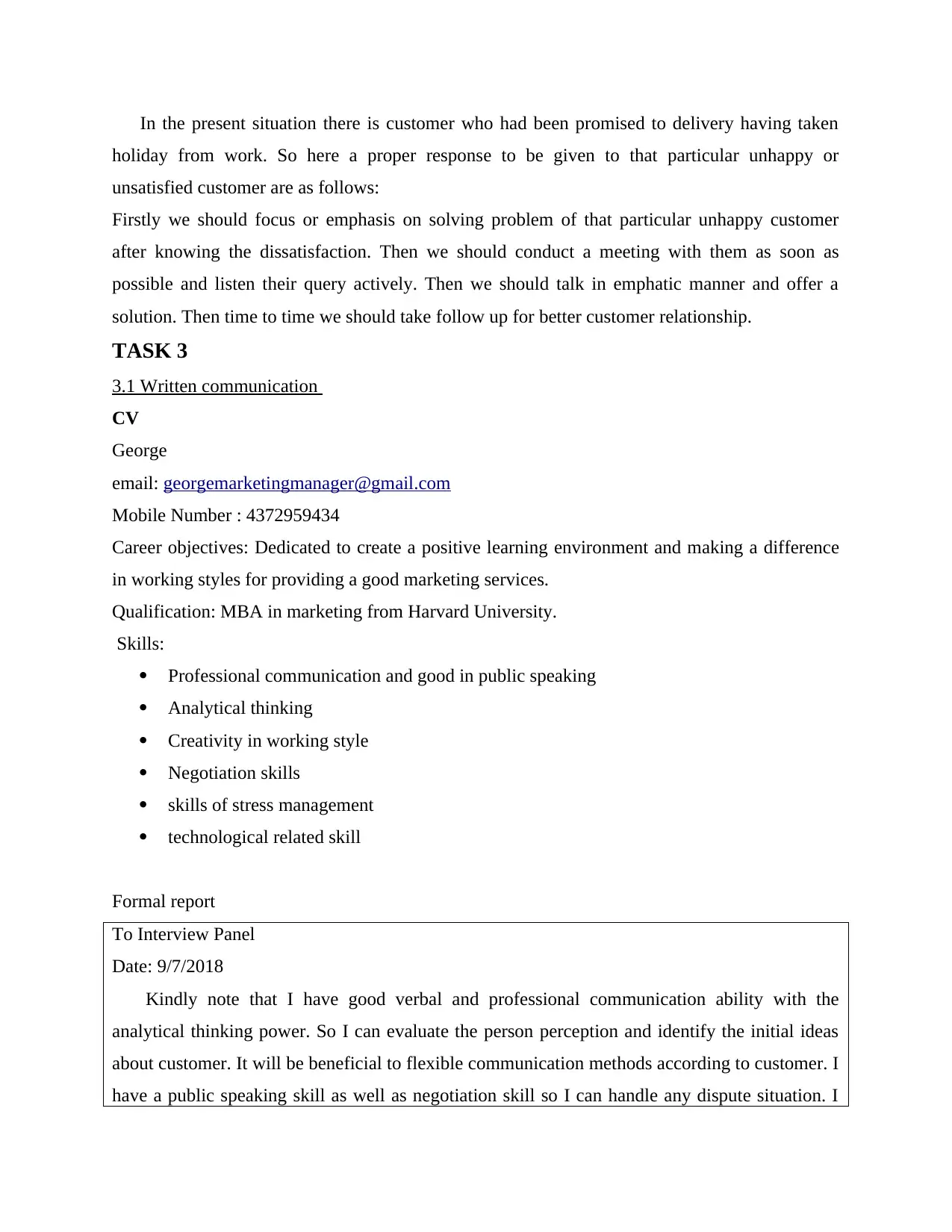
In the present situation there is customer who had been promised to delivery having taken
holiday from work. So here a proper response to be given to that particular unhappy or
unsatisfied customer are as follows:
Firstly we should focus or emphasis on solving problem of that particular unhappy customer
after knowing the dissatisfaction. Then we should conduct a meeting with them as soon as
possible and listen their query actively. Then we should talk in emphatic manner and offer a
solution. Then time to time we should take follow up for better customer relationship.
TASK 3
3.1 Written communication
CV
George
email: georgemarketingmanager@gmail.com
Mobile Number : 4372959434
Career objectives: Dedicated to create a positive learning environment and making a difference
in working styles for providing a good marketing services.
Qualification: MBA in marketing from Harvard University.
Skills:
Professional communication and good in public speaking
Analytical thinking
Creativity in working style
Negotiation skills
skills of stress management
technological related skill
Formal report
To Interview Panel
Date: 9/7/2018
Kindly note that I have good verbal and professional communication ability with the
analytical thinking power. So I can evaluate the person perception and identify the initial ideas
about customer. It will be beneficial to flexible communication methods according to customer. I
have a public speaking skill as well as negotiation skill so I can handle any dispute situation. I
holiday from work. So here a proper response to be given to that particular unhappy or
unsatisfied customer are as follows:
Firstly we should focus or emphasis on solving problem of that particular unhappy customer
after knowing the dissatisfaction. Then we should conduct a meeting with them as soon as
possible and listen their query actively. Then we should talk in emphatic manner and offer a
solution. Then time to time we should take follow up for better customer relationship.
TASK 3
3.1 Written communication
CV
George
email: georgemarketingmanager@gmail.com
Mobile Number : 4372959434
Career objectives: Dedicated to create a positive learning environment and making a difference
in working styles for providing a good marketing services.
Qualification: MBA in marketing from Harvard University.
Skills:
Professional communication and good in public speaking
Analytical thinking
Creativity in working style
Negotiation skills
skills of stress management
technological related skill
Formal report
To Interview Panel
Date: 9/7/2018
Kindly note that I have good verbal and professional communication ability with the
analytical thinking power. So I can evaluate the person perception and identify the initial ideas
about customer. It will be beneficial to flexible communication methods according to customer. I
have a public speaking skill as well as negotiation skill so I can handle any dispute situation. I
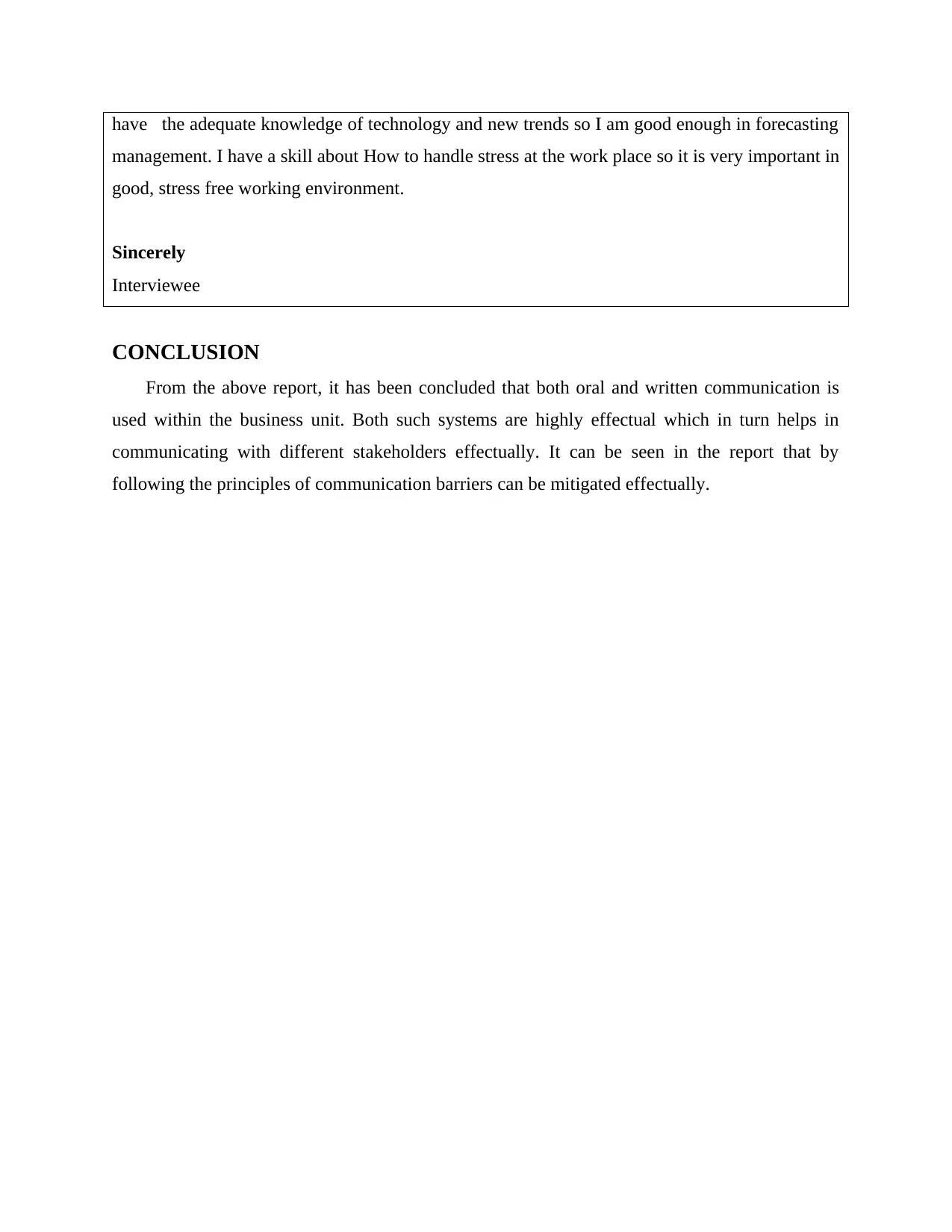
have the adequate knowledge of technology and new trends so I am good enough in forecasting
management. I have a skill about How to handle stress at the work place so it is very important in
good, stress free working environment.
Sincerely
Interviewee
CONCLUSION
From the above report, it has been concluded that both oral and written communication is
used within the business unit. Both such systems are highly effectual which in turn helps in
communicating with different stakeholders effectually. It can be seen in the report that by
following the principles of communication barriers can be mitigated effectually.
management. I have a skill about How to handle stress at the work place so it is very important in
good, stress free working environment.
Sincerely
Interviewee
CONCLUSION
From the above report, it has been concluded that both oral and written communication is
used within the business unit. Both such systems are highly effectual which in turn helps in
communicating with different stakeholders effectually. It can be seen in the report that by
following the principles of communication barriers can be mitigated effectually.
⊘ This is a preview!⊘
Do you want full access?
Subscribe today to unlock all pages.

Trusted by 1+ million students worldwide
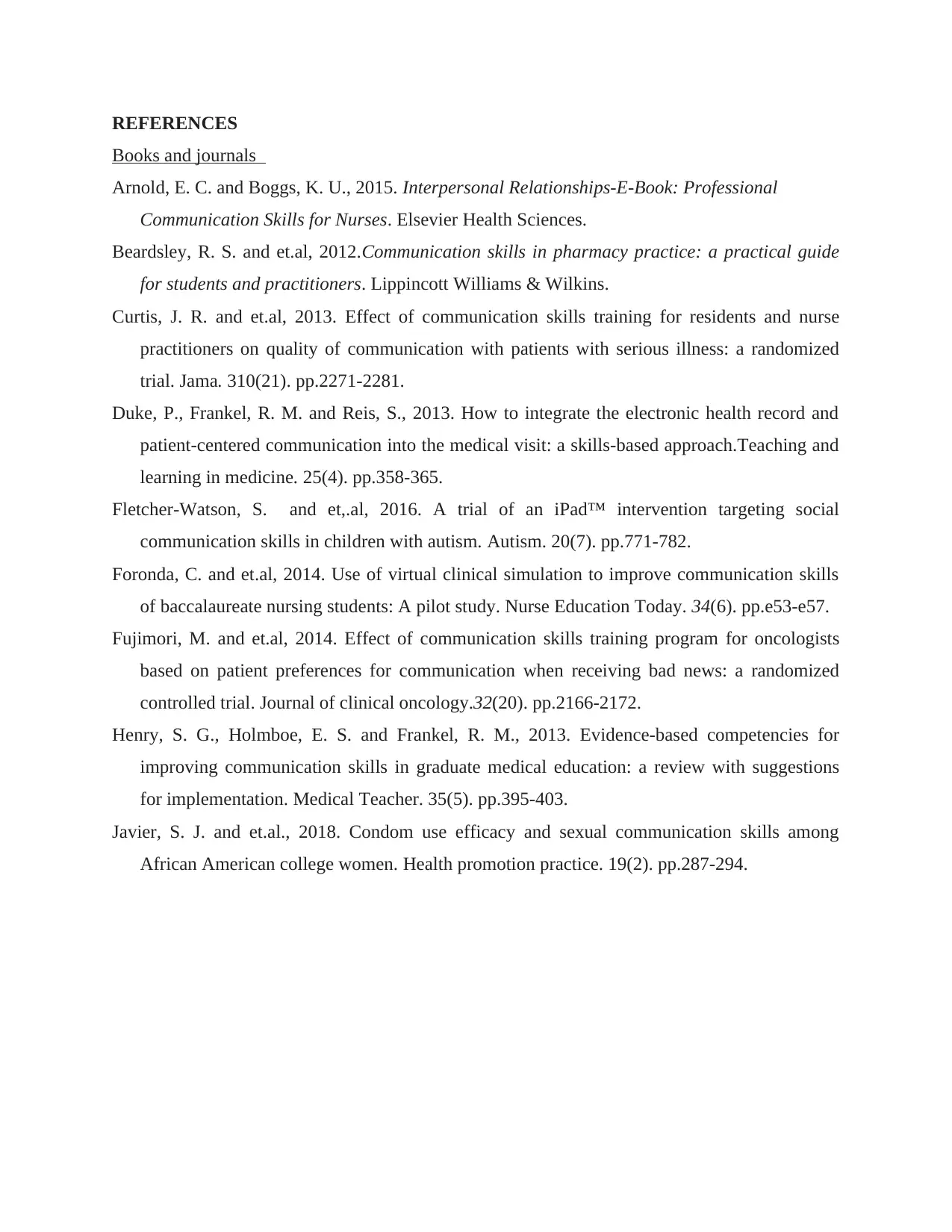
REFERENCES
Books and journals
Arnold, E. C. and Boggs, K. U., 2015. Interpersonal Relationships-E-Book: Professional
Communication Skills for Nurses. Elsevier Health Sciences.
Beardsley, R. S. and et.al, 2012.Communication skills in pharmacy practice: a practical guide
for students and practitioners. Lippincott Williams & Wilkins.
Curtis, J. R. and et.al, 2013. Effect of communication skills training for residents and nurse
practitioners on quality of communication with patients with serious illness: a randomized
trial. Jama. 310(21). pp.2271-2281.
Duke, P., Frankel, R. M. and Reis, S., 2013. How to integrate the electronic health record and
patient-centered communication into the medical visit: a skills-based approach.Teaching and
learning in medicine. 25(4). pp.358-365.
Fletcher-Watson, S. and et,.al, 2016. A trial of an iPad™ intervention targeting social
communication skills in children with autism. Autism. 20(7). pp.771-782.
Foronda, C. and et.al, 2014. Use of virtual clinical simulation to improve communication skills
of baccalaureate nursing students: A pilot study. Nurse Education Today. 34(6). pp.e53-e57.
Fujimori, M. and et.al, 2014. Effect of communication skills training program for oncologists
based on patient preferences for communication when receiving bad news: a randomized
controlled trial. Journal of clinical oncology.32(20). pp.2166-2172.
Henry, S. G., Holmboe, E. S. and Frankel, R. M., 2013. Evidence-based competencies for
improving communication skills in graduate medical education: a review with suggestions
for implementation. Medical Teacher. 35(5). pp.395-403.
Javier, S. J. and et.al., 2018. Condom use efficacy and sexual communication skills among
African American college women. Health promotion practice. 19(2). pp.287-294.
Books and journals
Arnold, E. C. and Boggs, K. U., 2015. Interpersonal Relationships-E-Book: Professional
Communication Skills for Nurses. Elsevier Health Sciences.
Beardsley, R. S. and et.al, 2012.Communication skills in pharmacy practice: a practical guide
for students and practitioners. Lippincott Williams & Wilkins.
Curtis, J. R. and et.al, 2013. Effect of communication skills training for residents and nurse
practitioners on quality of communication with patients with serious illness: a randomized
trial. Jama. 310(21). pp.2271-2281.
Duke, P., Frankel, R. M. and Reis, S., 2013. How to integrate the electronic health record and
patient-centered communication into the medical visit: a skills-based approach.Teaching and
learning in medicine. 25(4). pp.358-365.
Fletcher-Watson, S. and et,.al, 2016. A trial of an iPad™ intervention targeting social
communication skills in children with autism. Autism. 20(7). pp.771-782.
Foronda, C. and et.al, 2014. Use of virtual clinical simulation to improve communication skills
of baccalaureate nursing students: A pilot study. Nurse Education Today. 34(6). pp.e53-e57.
Fujimori, M. and et.al, 2014. Effect of communication skills training program for oncologists
based on patient preferences for communication when receiving bad news: a randomized
controlled trial. Journal of clinical oncology.32(20). pp.2166-2172.
Henry, S. G., Holmboe, E. S. and Frankel, R. M., 2013. Evidence-based competencies for
improving communication skills in graduate medical education: a review with suggestions
for implementation. Medical Teacher. 35(5). pp.395-403.
Javier, S. J. and et.al., 2018. Condom use efficacy and sexual communication skills among
African American college women. Health promotion practice. 19(2). pp.287-294.
1 out of 10
Related Documents
Your All-in-One AI-Powered Toolkit for Academic Success.
+13062052269
info@desklib.com
Available 24*7 on WhatsApp / Email
![[object Object]](/_next/static/media/star-bottom.7253800d.svg)
Unlock your academic potential
Copyright © 2020–2025 A2Z Services. All Rights Reserved. Developed and managed by ZUCOL.





